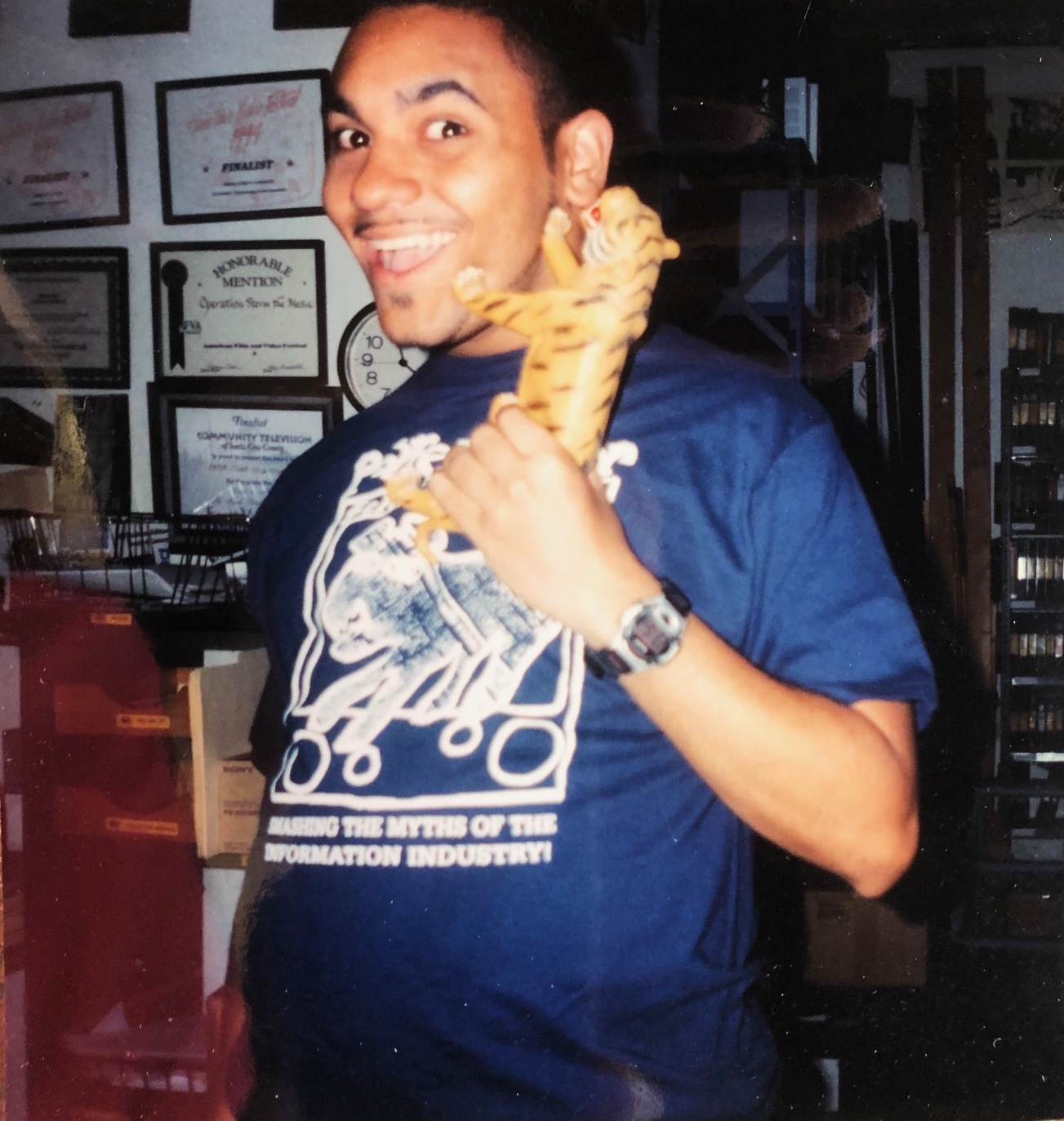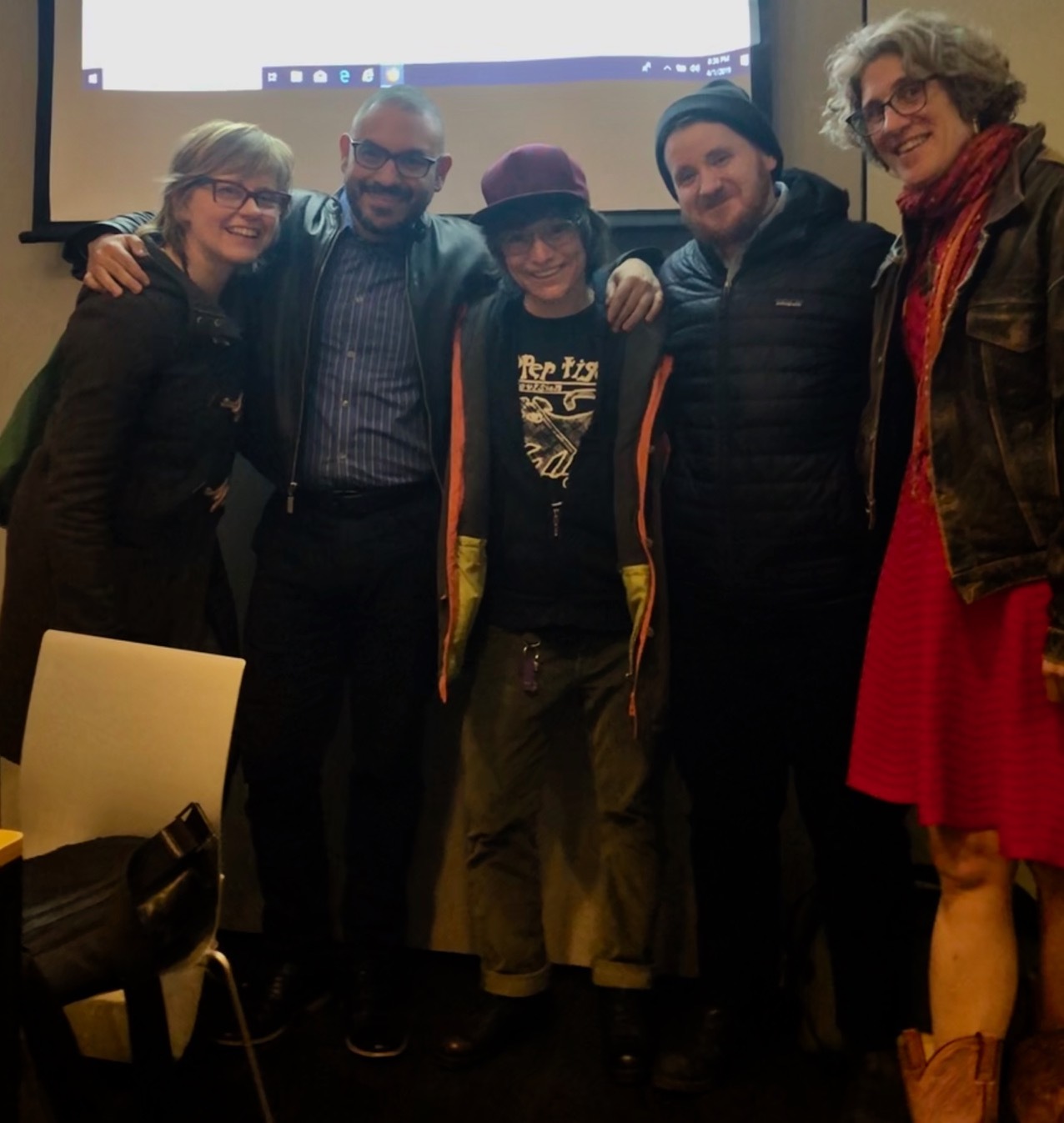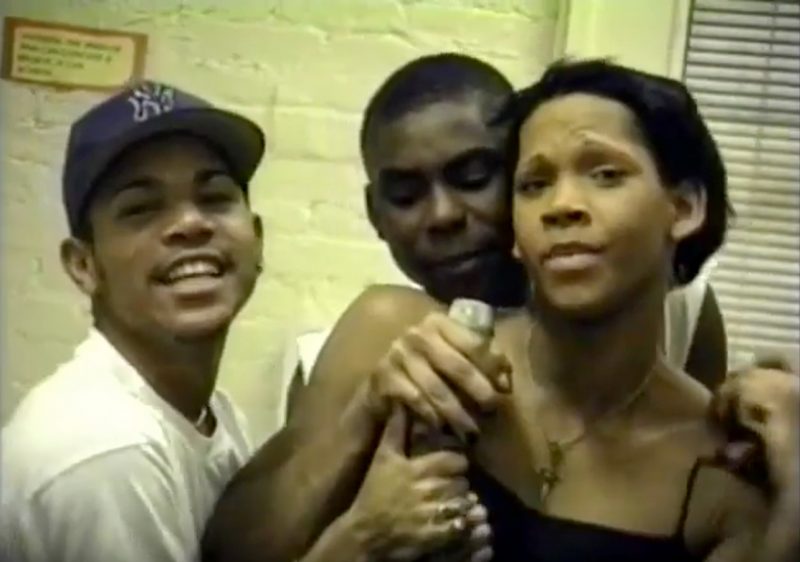The VHS Archives working group has been meeting for the last 2 years at the Graduate Center, CUNY, to think through questions of archiving, preserving, and activating VHS material as a collective process. For the last three meetings, working group members host a 'party,' a communal "gathering of humans to work collectively and in real-time" on the issues raised by the video material being shared. In the post below, working group member and artist Tara Mateik reflects on a party he hosted around Homecoming Queens (1999), a video made collaboratively between Paper Tiger TV and residents of Green Chimneys Gramercy, a group home for twenty young people in New York City foster care who identified as gay, bisexual, transgender or questioning.
Tara Mateik
It simply matters to hold something in your hands. Mementos. A treasure of smells, textures, and sounds that honor the impact of a person, a moment, a location in your own trajectory. What do you take with you from your past?
In 1981, a small group of activists and academics organized Paper Tiger Television in Dee Dee Halleck’s loft. The all-volunteer video collective worked to demystify and democratize the media. Originally developed out of the public-access television series Communications Update, Paper Tiger produced weekly live, half-hour shows every Wednesday night on public access cable network Manhattan Neighborhood Network (MNN).
In 1998, I was one of two staff people at Paper Tiger. At the time, our collective had offices in the A.J. Muste Building at 339 Lafayette Street. We shared the building with The War Resistors League (WRL), The Socialist Party USA, Deep Dish, and Revolution Out of Truth and Struggle (ROOTS). Surrounded by similar left-leaning organizers, we made our own t-shirts (“Giuliani = Police State”) and posters (“Fuck Corporate Media”). Every Wednesday, we met to sit in a circle with a rotating facilitator to address our collective agenda. Once a month, we oriented new people. We paid below-market rent. I wrote the checks, walked them down the hall, passing DeeDee and Tom at Deep Dish on my way. Our collective reflected the interests of our members, the chemistry between us and our shared resources. In 2015, The Muste (pronounced MUS-ty) Institute sold the building for $20.75 million to 337 Lafayette L.P., owned by the developer Aby Rosen. Today Paper Tiger is located in Brooklyn.
Homecoming Queens (1999) is a collaborative video created with Paper Tiger and residents of Green Chimneys Gramercy, a group home for twenty young people in New York City foster care who identified as gay, bisexual, transgender or questioning. There were four main participants who met with Paper Tiger twice a week: Javier, Cleudy, Aldeman, Meisha/Michael,
who met twice a week with representatives from Paper Tiger (Kathy High, Denise Gaberman, and myself) and a group co-facilitator, Gus Klein. Each participant produced and edited their own autobiographical vignette. Their interviews, experimental video essays, and direct-address monologues were linked together by clips from Green Chimneys “home movies.” I use the word “home movies” with some trepidation because, as Javier noted in his vignette, he didn’t consider Green Chimneys a home: “I just need a home. I need a home. I don’t consider this a home, at all.” But at the same time, we, the video facilitators, had been welcomed inside their classroom, their common spaces, and dining hall. We were on the stoop, at holidays, special occasions, and celebrations, gathering footage, documenting intimate moments in their lives.

When the tape was complete, we premiered to a sold out crowd at MIX Festival in NYC. The residents continued to screen the tape publicly and facilitated Q & A’s at conferences, during activist forums, and as part of targeted screenings with service providers where the residents were the experts and the service providers were the audience.
After Homecoming Queens, I stayed on to work with the residents on a video project about their experience working “the stroll.” Cleudy interviewed Roberto as she led a walking tour of the West Village: “I consider myself a career girl. I'm a working girl. I don’t consider myself a prostitute although what I do is prostitution…. This is where most of the drag queens stand, on this side, like over here is Cha Chas and Blacks and whatever. When it comes to Saturday nights and Friday nights, we basically block the whole street. I mean, all the way from, I’ll say, Greenwich all the way up there to 14th and it’s just full of drag queens and prostitutes. Some times real girls are out here. Some of the guys, they do come down from the butch queen stroll and they try to make some money down here. But because it’s not their spot they usually don’t.”
--
In 2019, as part of the VHS Archives Working Group here at the Graduate Center, I wanted to screen the 1999/2000 stroll tape. But we never finished the project; it was raw footage and no one, most importantly the young people featured, signed off on it for distribution. I was no longer in touch with the stroll tour guide. The material is important, but without consent, it wasn’t ethical to make it public.
The history of this tape is part of a larger history of displacement. In 2009, Green Chimneys temporarily closed 10 beds in its 20-bed program for homeless gay, lesbian, bisexual, and transgender young people because of city budget cuts. Some space was restored, but in 2012, the beds were cut again, from 25 to 10 while the Administration for Children’s Services was investigating allegations that the Green Chimneys staff “used excessive force, engaged in sexual misconduct and mismanaged residents’ finances.” In 2013, Antonio Lucas LaBoy started a Change.org protest to keep Green Chimneys Gramercy from closing. He wrote, “ACS is pushing the closure of the only group residence for 25 foster care youth, both male and female, who identify as lesbian, gay, bisexual, transgender, or questioning.”
Today, Green Chimneys Gramercy Group is listed as “permanently closed.” An image on Google Earth shows scaffolding at 327 E 22nd St. advertising Stalwart Construction: “Building Our Future”. Who’s our? Whose future? We are being disappeared, dispersed, and disenfranchised.
--
How does the significance of a home movie shift if you don’t have a home? For those who grew up in institutions, foster care, shelters, detention centers, what documents remain? What does the record convey without first person narratives?
As Javier Justino Collazo said, “I don’t have an archive of my own life. It’s important that it exists.”
But collaborations and shared histories can spark connections that are all the more treasured for persisting, despite displacement. Javier is now a translator with multiple degrees working for the NYC Mayor’s Office for Immigrant Affairs. He and I have kept in touch. When he aged out of foster care, he stayed at my place. We’d reconnect in Puerto Rico when he was doing environmental activism. We’ve had shared birthday parties (He’s a Leo). I’ve met his boyfriends, and now his life partner. We’ve spent holidays together. He’s cared for my animals. We’re family. Gus Klein is now Postdoctoral Fellow and Senior Research Associate at the Hunter HIV/AIDS Research Team. He has remained one of my closest and dearest friends. I met his grandma. We’ve gone on vacations together, done century rides, walked our dogs, eaten meals, and shared birthdays (He’s a Leo). He was there for my top surgery. And I was there for his wedding. We’re family. On April 1, 2019 we had a family reunion.
--

For my party, 1990s dress code was optional and it was a BYOA (bring your own artifact) affair. Specifically I asked people to bring an object or image that relates to an interior, private, and emotionally charged place. Alex wore her best friend Jim’s leather bomber jacket; Devika and Kyle brought journals from their youth; Kyle also invited Nancy Chong, Development Associate, from Visual AIDS; Amy, brought her collection of hospital waiting room post cards; and Gus, the Homecoming Queens flyer. Javier had a photograph I had saved for him, a snapshot of himself with Cluedy, Aldeman, and Meisha/Michael. I brought a letter approving my top surgery.
We watched Homecoming Queens (1999) with the VHS group. We sometimes offered voiceover commentary or a laugh track. We talked about the complication of making public and distributing works that expose emotionally and politically charged interior and private spaces. For my party exercise, we started on a collective zine grappling with these questions. A keepsake. A takeaway. Memory is fragile. I want to touch it.
And Partners & Partners heard the call. For the last two years, the design team has been developing a tool to support a physical archive. Each archive begins with a short stack video archive. A collection is generally private—not for distribution, or grassroots—intended for shifting the political conversation; is intended for sharing (without compromising anyone’s safety), and caring connects people to a personal collection and physical archive. After uploading directly to archives.org, materials can be private or public. A party follows, usually with hands-on games and testimonials; we reactivate material, often adding artifacts like flyers, photos, and timelines to supplement the videos.
We will not be disappeared.

